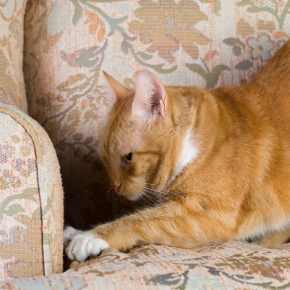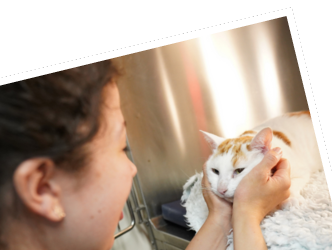
Daventry Vets’ advice to reduce furniture damage from your cat
January 21, 2024
Cats are beloved members of the family but sometimes their scratching can be quite frustrating. Your cat does not care that your furniture and carpets shouldn’t be clawed at, so the team at Daventry Vets have compiled a list of advice on how to control the furniture scratching whilst also promoting your cat’s wellbeing. Contact us on 01327 877767 for more advice and share your tips on our Facebook page.
Visit our Facebook page and share your cat tips
Why do cats scratch?
According to vet Sarah Aldridge, scratching is a perfectly normal and healthy behaviour for cats. It serves several purposes, including:
- Claw maintenance: to keep nails sharp, cats will scratch their claws to shed the outer layers, keeping them healthy.
- Territory marking: scratching deposits scent marks from glands on their paws to establish their territory. The outer layers of claws left behind and the scratch marks themselves are also territory markers.
- Exercise: Scratching exercises the forelimbs and spine.
- Stress: cats can scratch in more areas when they feel insecure. This can happen in multi cat households or in areas where there are high numbers of cats.
How to reduce furniture and carpet damage from cat scratching
- Provide scratching posts and pads strategically near furniture that your cat has targeted before. If they are made from materials such as cardboard, sisal and carpet, it will really help to satisfy your cat’s scratching needs.
- Make sure scratching posts are high enough for your cat at full stretch.
- The team at Daventry Vets recommend using either double-sided tape or sticky pads on furniture that your cat scratches to act as a deterrent as cats don’t like sticky surfaces (make sure it is non toxic)
- Use catnip on scratching posts and pads to make them attractive to your cat, some scratching posts already have catnip impregnated into them.
- Cats often scratch to mark their territory so offering them more space can help. Provide them vertical spaces like shelves and cat trees and offer them praise and treats when they use them correctly. This positive reinforcement will help to prolong the life of your furniture!
- Use Feliway diffusers to decrease stress.
- Play with toys near scratching posts to encourage your cat to use them.
- Clipping cats claws can be part of the solution but should only be used for totally indoor cats as indoor-outdoor cats may need to use their claws to climb a fence to escape or for defence if attacked.
Changing any cat’s behaviour takes time so patience and consistency is key to success.
By providing your cat with suitable scratching alternatives, you can protect your furniture whilst ensuring your cat leads a happy and healthy life.



